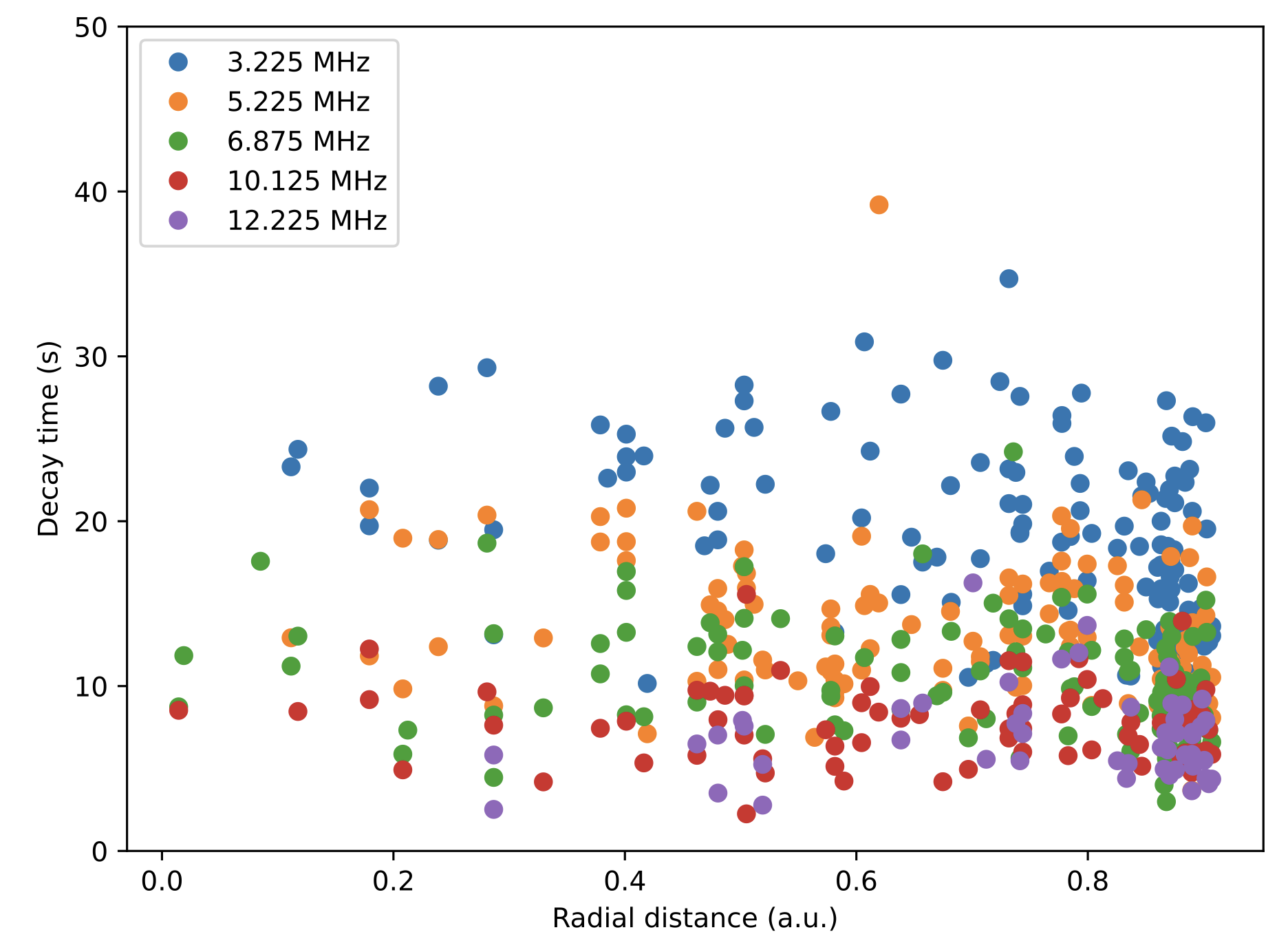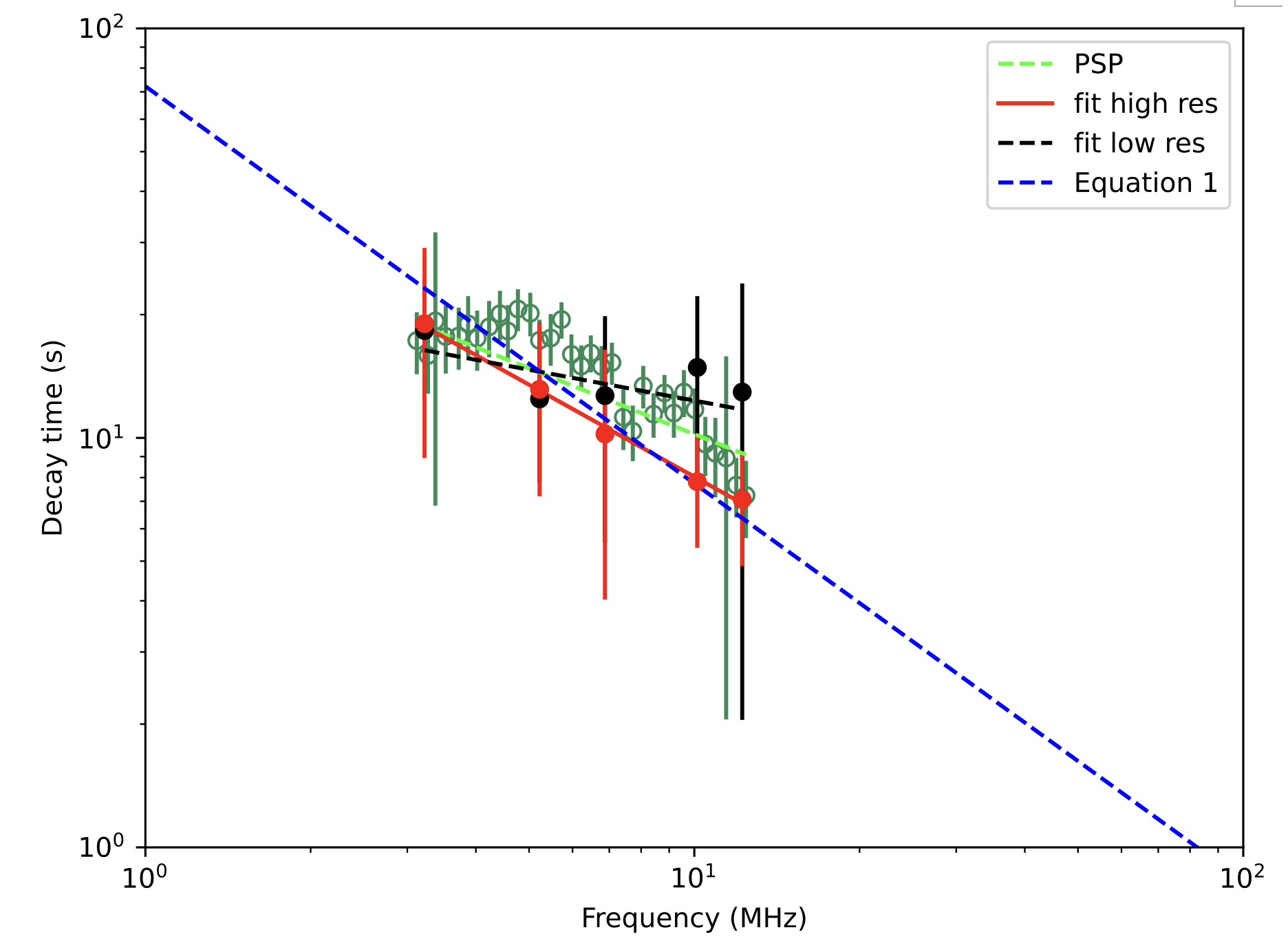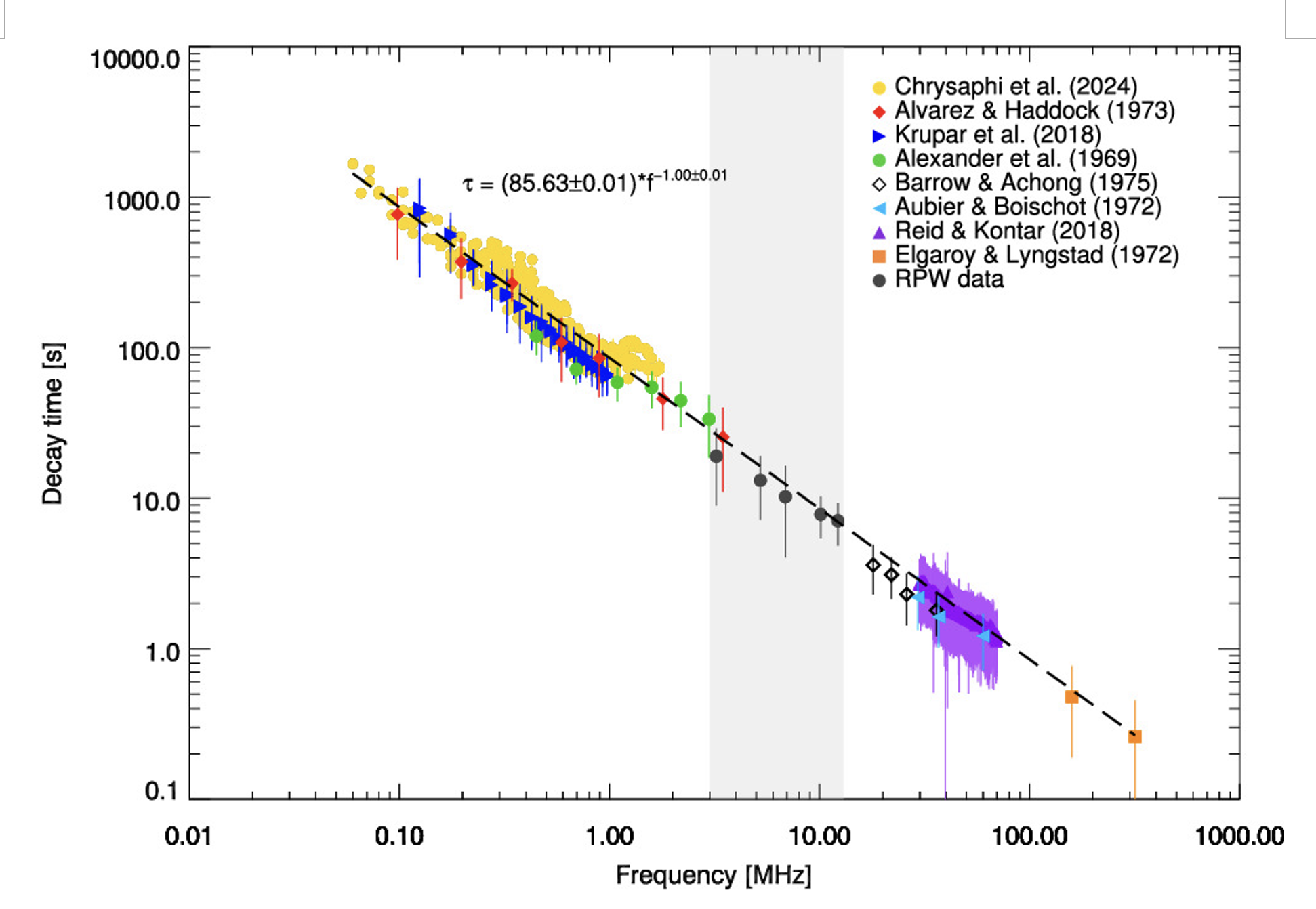Science nugget: Temporally resolved Type III solar radio bursts in the frequency range 3-13 MHz - Solar Orbiter
Temporally resolved Type III solar radio bursts in the frequency range 3-13 Mhz
(Solar Orbiter Nugget #41 by Antonio Vecchio1, 2, Milan Maksimovic2, Nicolina Chrysaphi3,4, Eduard P. Kontar4, Vratislav Krupar5, 6)
Introduction
Radio waves occupy the longest wavelength region of the electromagnetic spectrum. Different astronomical objects, characterized by a varying magnetic field, produce radio waves. The first quasars were identified in the late 50s as radio sources with no corresponding signal in the visible light. Astronomers produced the first image of a black hole in 2019 by visualizing the radio emission from hot gas swirling around it under the effect of strong gravity fields close to the event horizon.
The Sun is one of the strongest radio sources in the sky producing several kinds of radio emissions differing in characteristics, intensity and mechanism of production. Type III radio bursts are the most common coherent radio emission produced by the Sun. They are characterized by a rapid drift in time towards lower frequencies (f) and represent an indirect signature of energetic electrons produced at the Sun during a flare and propagating through the plasma of the corona and the interplanetary medium with subluminal speed (typically 0.3-0.1c). Type III radio bursts are observed over a wide range of frequencies ranging from about ∼500 MHz down to tens of kHz close to 1 au, corresponding to a wide range of heliocentric distances.
Density fluctuations along the path of the solar radio waves can strongly affect the propagation and the properties of the detected type III bursts. Scattering of radio waves on random density irregularities has long been recognized as an important process for the interpretation of radio source sizes (e.g. [1]), positions (e.g. [2,3]), directivity (e.g. [4-6]), and intensity-time profiles (e.g. [7]). Due to the scattering, the intensity-time profiles of a radio burst are characterized by a very fast rising phase followed by a long-lasting exponential decrease [8] (see Figure 1). Since decay times are directly related to the radio-wave scattering, their analysis provides useful information about the strength and anisotropy of the scattering process [9,10] and the level of density fluctuations [7,11].
When the measured decay time τ is represented as a function of frequency, it follows a power law f^(−β), where β=-0.970 +/- 0.003 [9]. However, a data gap, marking the separation between measurements from space and on ground, is present between 3 and 13 MHz due to the lack of temporally resolved measurements.
Decay time measurements in this frequency range can only be made from space as the Earth’s ionosphere partially reflects and absorbs the signals below ∼10 MHz. Accurate decay time measurements in this frequency range are therefore needed to confirm the expected trend and characterize, through observational data, the scattering in the radial distance belt between 2 and 5 R☉ that currently remains unexplored. The few observations present in the literature [12-14], performed with sampling time larger than 3.5 s, found quite different β values due to the various low temporal resolutions of the data sets, not allowing for the measurements to be resolved. A sufficiently high temporal resolution (lower than 0.5s) is indeed needed to properly sample signals with expected decay times of the order of 1-10 s.
The SO/RPW/HFR Observations
The High Frequency Receiver (HFR) [15,16] of the RPW instrument on board Solar Orbiter was configured to acquire five frequencies [3.225, 5.225, 6.875,10.125, 12.225] MHz for ten times followed by a sweep on 50 frequencies between 0.425 and 16.325 MHz. This novel configuration, including performing an average on the lowest possible number of spectra [16] and measuring at only one sensor V1–V2, allows to reach, for each of the five chosen frequencies, a time resolution of ∼0.07s and an average resolution of∼0.18 s (Figure 1), significantly better than previous measurements.

Figure 1: Intensity-time profiles of the radio flux density measured by SO/RPW/HFR at five frequency channels during a type III burst on 2023 November 26. The exponential decrease is clearly visible in the data and is highlighted by a red line showing the results of the decay time fitting.
Results and Discussion
The dataset obtained over about 13 months of observation, is unique in the framework of space observations since the achieved sample time is up to 2 orders of magnitude higher than any other spacecraft measurements. By analyzing HFR power spectral densities from calibrated level 2 (L2) data, more than 350 type III bursts have been identified. Decay times were obtained through an exponential fit on the data.
The large number of detected events allowed to statistically characterize the decay time in the range 3-13 MHz, with the following conclusions:
- For each of the considered frequency the decay time does not depend on the radial distance of the spacecraft but only on the frequency (Figure 2).

Figure 2: Decay time as a function of the radial distance for the five considered frequencies. No radial distance dependence is observed.
2. the time resolution of the data set is the decisive factor for the proper measurement of decay times and the accurate determination of the τ spectral index in the considered frequency range. The time resolution of the measurements used in previous works was insufficient to accurately characterize the decay time at frequencies higher than 6 MHz since the sampling time is comparable to the expected decay time (Figure 3).

Figure 3: Decay times for the five considered frequencies obtained as the median value from the sample of measurements. Red: full time resolution original data set; black: data set with time resolution reduced to 3.5 s; green: PSP data set with 3.5 s resolution. Error bars represent the standard error. The black, red, and lime lines correspond to the power-law fit on the respective five data points. The blue dashed line shows the power-law function with β= -0.970 from Equation 1 of [9]. The comparison of the decay time trends at different time resolutions shows that in the frequency range 3-13 MHz the discrepancy with Equation 1 increases when the time resolution of the data set decreases, and a flatter trend is obtained.
3. HFR measurements allowed to fully characterize the τ behavior as a function of frequency in the range 3-13 MHz and to fill the long-standing gap in the observations of type III burst decay times. Our observations show that the τ-f power law trend does not change in the radial distance range 2-5 R⊙, and a spectral index β=-1 is representative in the full 1-100 R⊙ range (Figure 4).

Figure 4: Median decay time values from measured type III bursts in the frequency range of 3–13 MHz (shaded region), superimposed on the data shown in Figure 10 of [9] and the newly added data from [17]. Error bars represent the standard error obtained from observations. The best-fit function is also printed.
Acknowledgements
The RPW instrument has been designed and funded by CNES, CNRS, the Paris Observatory, the Swedish National Space Agency, ESA-PRODEX and all the participating institutes.
N.C. acknowledges funding support from the Initiative Physique des Infinis (IPI), a research training program of the Idex SUPER at Sorbonne Université.
EPK was supported via the STFC/UKRI grants ST/T000422/1 and ST/Y001834/1.
Afilliations
[1] Radboud Radio Lab, Department of Astrophysics, Radboud University, Nijmegen, The Netherlands
[2] LESIA, Observatoire de Paris, Université PSL, CNRS, Sorbonne Université, Université de Paris,5 place Jules Janssen,92195 Meudon, France
[3] Sorbonne Université, Ecole Polytechnique, Institut Polytechnique de Paris, CNRS, Laboratoire de Physique des Plasmas(LPP), 4 Place Jussieu, 75005 Paris, France
[4] School of Physics & Astronomy, University of Glasgow, Glasgow, G12 8QQ, UK
[5] Goddard Planetary Heliophysics Institute, University of Maryland, Baltimore County, Baltimore, MD 21250, USA
[6] Heliospheric Physics Laboratory, Heliophysics Division, NASA Goddard Space Flight Center, Greenbelt, MD 20771,USA
References
[1] Steinberg, J. L., Aubier-Giraud, M., Leblanc, Y., & Boischot, A. 1971, A&A, 10, 362
[2] Fokker, A. D. 1965, BAN, 18, 111
[3] Stewart, R. T. 1972, PASA, 2, 100, doi: 10.1017/S1323358000013059
[4] Thejappa, G., MacDowall, R. J., & Kaiser, M. L. 2007, ApJ, 671, 894, doi: 10.1086/522664
[5] Bonnin, X., Hoang, S., & Maksimovic, M. 2008, A&A, 489, 419, doi: 10.1051/0004 6361:200809777
[6] Reiner, M. J., Goetz, K., Fainberg, J., et al. 2009, SoPh, 259, 255, doi: 10.1007/s11207-009-9404-z
[7] Krupar, V., Maksimovic, M., Kontar, E. P., et al. 2018, ApJ, 857, 82, doi: 10.3847/1538-4357/aab60f
[8] Evans, L. G., Fainberg, J., & Stone, R. G. 1973, SoPh, 31, 501, doi: 10.1007/BF00152825
[9] Kontar, E. P., Chen, X., Chrysaphi, N., et al. 2019, ApJ, 884, 122, doi: 10.3847/1538-4357/ab40bb
[10] Chen, X., Kontar, E. P., Chrysaphi, N., et al. 2020, ApJ, 905, 43, doi: 10.3847/1538-4357/abc24e
[11] Krupar, V., Szabo, A., Maksimovic, M., et al. 2020, ApJS, 246, 57, doi: 10.3847/1538-4365/ab65bd
[12] Hartz, T. R. 1964a, Annales d’Astrophysique, 27, 831; Hartz, T. R. 1964b, Annales d’Astrophysique, 27, 823
[13] Boischot, A. 1967, Annales d’Astrophysique, 30, 85; Boischot, A., Lee, R. H., & Warwick, J. W. 1960, ApJ, 131, 61, doi: 10.1086/146807
[14] Jebaraj, I. C., Krasnoselskikh, V., Pulupa, M., Magdalenic, J., & Bale, S. D. 2023, ApJL, 955, L20, doi: 10.3847/2041-8213/acf857
[15] Maksimovic, M., Souček, J., Chust, T., et al. 2021, A&A, 656, A41, doi: 10.1051/0004-6361/202141271
[16] Vecchio, A., Maksimovic, M., Krupar, V., et al. 2021, A&A, 656, A33, doi: 10.1051/0004-6361/202140988
[17] Chrysaphi, N., Maksimovic, M., Kontar, E. P., et al. 2024, A&A, 687, L12, doi: 10.1051/0004-6361/202348175
- Removed a total of (4) style margin:0;
Nuggets archive
2025
19/03/2025: Radial dependence of solar energetic particle peak fluxes and fluences
12/03/2025: Analysis of solar eruptions deflecting in the low corona
05/03/2025: Propagation of particles inside a magnetic cloud: Solar Orbiter insights
19/02/2025: Rotation motions and signatures of the Alfvén waves in a fan-spine topology
12/02/2025: 'Sun'day everyday: 2 years of Solar Orbiter science nuggets that shed light on some of our star's mysteries
22/01/2025: Velocity field in the solar granulation from two-vantage points
15/01/2025: First joint X-ray solar microflare observations with NuSTAR and Solar Orbiter/STIX
2024
18/12/2024: Shocks in tandem : Solar Orbiter observes a fully formed forward-reverse shock pair in the inner heliosphere
11/12/2024: High-energy insights from an escaping coronal mass ejection
04/12/2024: Investigation of Venus plasma tail using the Solar Orbiter, Parker Solar Probe and Bepi Colombo flybys
27/11/2024: Testing the Flux Expansion Factor – Solar Wind Speed Relation with Solar Orbiter data
20/11/2024:The role of small scale EUV brightenings in the quiet Sun coronal heating
13/11/2024: Improved Insights from the Suprathermal Ion Spectrograph on Solar Orbiter
30/10/2024: Temporally resolved Type III solar radio bursts in the frequency range 3-13 MHz
23/10/2024: Resolving proton and alpha beams for improved understanding of plasma kinetics: SWA-PAS observations
25/09/2024: All microflares that accelerate electrons to high-energies are rooted in sunspots
25/09/2024: Connecting Solar Orbiter and L1 measurements of mesoscale solar wind structures to their coronal source using the Adapt-WSA model
18/09/2024: Modelling the global structure of a coronal mass ejection observed by Solar Orbiter and Parker Solar Probe
28/08/2024: Coordinated observations with the Swedish 1m Solar Telescope and Solar Orbiter
21/08/2024: Multi-source connectivity drives heliospheric solar wind variability
14/08/2024: Composition Mosaics from March 2022
19/06/2024: Coordinated Coronal and Heliospheric Observations During the 2024 Total Solar Eclipse
22/05/2024: Real time space weather prediction with Solar Orbiter
15/05/2024: Hard X ray and microwave pulsations: a signature of the flare energy release process
01/02/2024: Relativistic electrons accelerated by an interplanetary shock wave
11/01/2024: Modelling Two Consecutive Energetic Storm Particle Events observed by Solar Orbiter
2023
14/12/2023: Understanding STIX hard X-ray source motions using field extrapolations
16/11/2023: EUI data reveal a "steady" mode of coronal heating
09/11/2023: A new solution to the ambiguity problem
02/11/2023: Solar Orbiter and Parker Solar Probe jointly take a step forward in understanding coronal heating
25/10/2023: Observations of mini coronal dimmings caused by small-scale eruptions in the quiet Sun
18/10/2023: Fleeting small-scale surface magnetic fields build the quiet-Sun corona
27/09/2023: Solar Orbiter reveals non-field-aligned solar wind proton beams and its role in wave growth activities
20/09/2023: Polarisation of decayless kink oscillations of solar coronal loops
23/08/2023: A sharp EUI and SPICE look into the EUV variability and fine-scale structure associated with coronal rain
02/08/2023: Solar Flare Hard Xrays from the anchor points of an eruptive filament
28/06/2023: 3He-rich solar energetic particle events observed close to the Sun on Solar Orbiter
14/06/2023: Observational Evidence of S-web Source of Slow Solar Wind
31/05/2023: An interesting interplanetary shock
24/05/2023: High-resolution imaging of coronal mass ejections from SoloHI
17/05/2023: Direct assessment of far-side helioseismology using SO/PHI magnetograms
10/05/2023: Measuring the nascent solar wind outflow velocities via the doppler dimming technique
26/04/2023: Imaging and spectroscopic observations of EUV brightenings using SPICE and EUI on board Solar Orbiter
19/04/2023: Hot X-ray onset observations in solar flares with Solar Orbiter/STIX
12/04/2023: Multi-scale structure and composition of ICME prominence material from the Solar Wind Analyser suite
22/03/2023: Langmuir waves associated with magnetic holes in the solar wind
15/03/2023: Radial dependence of the peak intensity of solar energetic electron events in the inner heliosphere
08/03/2023: New insights about EUV brightenings in the quiet sun corona from the Extreme Ultraviolet Imager








































 Sign in
Sign in
 Science & Technology
Science & Technology